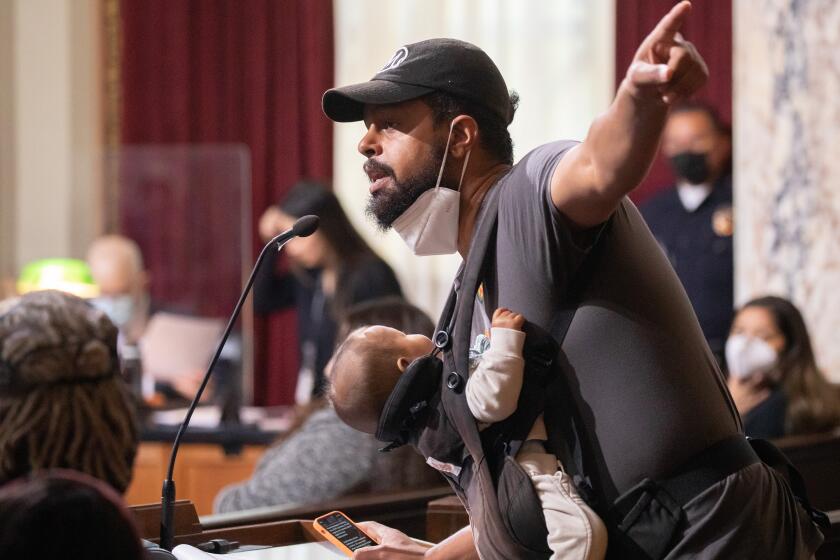‘89 Ruling Led to Sharp Drop in Cities’ Hiring of Minority Firms : Affirmative action: Contracts dried up after San Diego curbs were put in place. Stories of municipalities may offer lessons on effect of recent high court decision.
When a court stopped the city of San Diego from enforcing affirmative action rules in awarding city contracts, contractors stopped hiring women- and minority-owned firms.
“It was disastrous,” said Debra Fischle-Faulk, the city’s equal opportunity contracting manager, reviewing 1994 figures. Participation rates for minorities plunged from a high of 21.3% to about 2% after the court ruling.
San Francisco, also under court pressure, had to drop a requirement that Asian Americans be given preference because a study found that they received more than a quarter of the city’s architectural contracts. No longer under pressure to subcontract with Asian-owned firms, general contractors stopped using them.
These are among the war stories of municipalities hit hard by a 1989 U.S. Supreme Court ruling limiting affirmative action rules for city and state contracts. The court said the local programs had to be justified and tailored to meet a documented, compelling governmental interest.
Now, under a new Supreme Court ruling, $17 billion in federal affirmative action programs must meet the same standard, making the experiences of states and cities particularly instructive.
Although the ramifications of the June 12 decision are not fully known, affirmative action advocates contend that the experiences of cities show that programs can be saved if the government is willing to revise them or produce documentation that justifies their necessity.
The 1989 ruling forced some cities to shelve programs temporarily, drastically reducing business opportunities and cutting off work for some women- and minority-owned firms. But cities also found they could restructure their programs to comply with the ruling, and participation levels bounced back.
Cities accomplished this by ordering so-called disparity studies, which can cost hundreds of thousands of dollars and take years to complete. This research examines whether certain women- or minority-owned firms were previously denied contracts because of discrimination. If discrimination could be documented, affirmative action could be reinstituted under a revised program.
Although federal programs might be similarly saved, some advocates fear that politics may prevent the U.S. government from doing what is necessary to bring the programs into compliance.
“Congress may not be willing to do the studies to justify maintaining the programs,” said Michael Harris, staff lawyer for the San Francisco-based Lawyers Committee for Civil Rights. “That is the more fundamental hurdle.”
The new ruling, like its predecessor, can only be enforced if someone brings a lawsuit against a program. In California, several cities and governmental agencies were hit with such suits after the 1989 decision.
Anticipating a legal challenge, the city of Los Angeles ordered a disparity study and revamped its program. After spending $340,000 and waiting 3 1/2 years for the study, the City Council scrapped it as flawed. It showed that Latino businesses needed substantially more help but suggested that African Americans already were getting a lot of city work.
No new study has been ordered, and city officials have replaced their former system of numerical goals with an outreach effort that requires contractors to demonstrate that they tried to recruit women and minorities.
Assistant Los Angeles City Atty. Christopher M. Westhoff said minority and women participation has dropped only slightly with the new program, which a contractor has challenged in court.
Some contractors complain that city officials will not award them contracts without having significant minority and women participation, even though the outreach program only requires evidence of attempted recruitment.
“The minority outreach program is a charade,” complained a representative of contractors who refused to speak for attribution. “The politicians use it to enforce quotas. If you don’t satisfy them that you are meeting their goals, they frequently find other excuses to reject your submission.”
California contractors who have sued to stop affirmative action in government contracting have often won their cases in court only to see the city or agencies revise their programs in a way that still provides for preferences, said Thomas Holsman, executive vice president of the Associated General Contractors of California.
“We have spent hundreds of thousands of dollars,” said Holsman, “and every time we got a decision, it was in our favor but the program got changed” rather than killed.
Some agencies have done studies that discovered not all minority-owned firms qualified for special treatment. Aaron Chong, a Sacramento city coordinator who works with small business, said some minority-owned prime contractors in Sacramento now must meet the same requirements as the white contractors: Both are obligated to look for minority- and women-owned subcontractors.
Sacramento, which was not sued, revised its affirmative action program as a precaution. Minority and women participation has risen under the new system, designed on the basis of a disparity study, Chong said.
“It does take some political will,” said Chong, “and we have been fortunate to have it in Sacramento.”
Gov. Pete Wilson, a critic of affirmative action, has vetoed legislation that would allow California to do a study to defend its affirmative action goals, which have never been challenged in court. The Republican Congress also has pledged to reduce affirmative action.
President Clinton, however, has called the programs “good for America” and suggested revising programs that may be legally vulnerable rather than scuttling them. “Mend it, but don’t end it,” Clinton said in a speech last Wednesday.
Indicating that the Administration may follow the example of cities, Clinton suggested setting aside contract dollars for companies that locate in or hire from poor neighborhoods, regardless of the race of the owners. This presumably would benefit minority firms and still comply with the new ruling.
Without such tinkering, some programs could be thrown out by courts. When this happened in California, minority firms lost substantial business.
“It was this incredibly shocking picture of non-cooperation,” recalled San Francisco Deputy City Atty. Mara E. Rosales, citing the failure of contractors to hire Asians once they were dropped from the affirmative action program.
Ironically, it was this failure that gave the city legal grounds to reinstate Asians into the program. San Francisco now has a strong affirmative action program again.
“We have everything we had [before the 1989 decision], except instead of applying to all minorities outside the county,” Rosales said, “we now only apply it to economically disadvantaged women and minorities in San Francisco.”
San Diego, which lost its previous program in 1993 because of a court order, has recently completed a $400,000 disparity study, the groundwork for creating a new affirmative action program.
In the meantime, however, some women- and minority-owned subcontractors are impatient.
“Once that program was eliminated, no one called me anymore,” said Laura da Silva Sims, owner of a San Diego electrical supply company that she said has competitive prices. “The jobs are still going on, the work is still going on, but no one is calling me. . . .”
More to Read
Start your day right
Sign up for Essential California for news, features and recommendations from the L.A. Times and beyond in your inbox six days a week.
You may occasionally receive promotional content from the Los Angeles Times.







